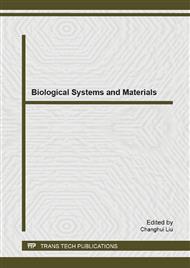p.150
p.159
p.165
p.173
p.177
p.182
p.188
p.193
p.199
The Crystal Structure and Mechanical Characteristics of Enamel and Dentin of Primary and Permanent Teeth
Abstract:
Objective: To test and contrastive analysis the crystal structure and mechanical characteristics of enamel and dentin of primary and permanent teeth by XRD and contact angle meter, provide information and experimental data for bionics and designs of dental materials. Methods: Teeth were randomly divided into four groups, including permanent teeth enamel group, permanent teeth dentin group, primary teeth enamel group, and primary teeth primary teeth. The crystal structure and mechanical characteristics of teeth were tested by XRD and contact angle meter. The results were analyzed with one-way ANOVA. Results: The crystalline and grain size of enamel were significantly larger than dentin’s. The crystalline and grain size of enamel and dentin of permanent teeth were also larger than primary teeth. Conclusions: The XRD and contact angle of primary and permanent teeth are closely related to their structures, Dental filling material to give full consideration to their different property.
Info:
Periodical:
Pages:
177-181
Citation:
Online since:
May 2014
Authors:
Keywords:
Price:
Сopyright:
© 2014 Trans Tech Publications Ltd. All Rights Reserved
Share:
Citation:


